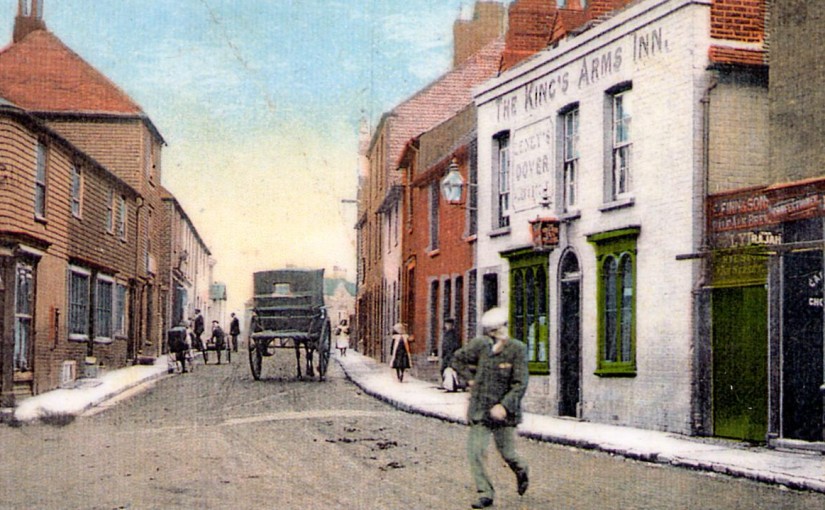By Arthur Woodgate
The sea until 1300 would have washed the north side of Rye with a causeway across to Rye Hill. Wrecks of ships have been found in streets north of the Town wall and of boats where the town ditch was. The town ditch was dug along the north of the town wall for extra defence; it would have gone from the strand gate to the bottom of Tower Street, so when Cinque Ports Street started to develop the ditch would have been filled in.
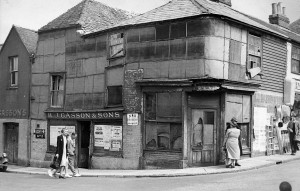
Now starting from what we knew as Longleys Corner, taking the corner as a trading site, we find three pubs. Two are still there but one has been shut, and so what I can remember as a green grocers was once the Kings Arms and was close to a passage leading to the Mint; everyone now calls it the “Needles”, but I can remember the name “Vennall Passage” up on the side of a house just inside the bottom of the passage, which ran through the town wall. Keeping on the town side, several houses were built some of which have since been used for trading. That leads us to a big shop with warehouse over and when I first remember it had H J Gasson all over it and it was the place to go if you needed good hard working clothes. Gassons were well established traders all over town and I have no doubt they had this building put up on part of the ditch. Now back to Longleys Corner, where, at the turn of the century (1900) Longley’s had a grocery store. Gassons later had a shop on the same site and locally it became known as Gassons Corner. Next door was the “Crown Inn” the Crown field runs behind on what was the old sea bottom and now forms the north side of Cinque Ports Street. Part of the old Gasson building on the corner was pulled down after the Second World War when the Bannisters Brothers had the building as an Ironmongers. They have gone now but the corner is now known as Bannisters Corner, although I suspect it is still called Longley’s Corner officially.
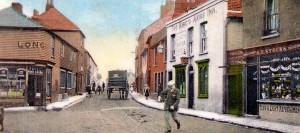
Back across the road for a short time and a shop at the bottom of the “Needles” was pulled down, but I don’t know why. It was run by “Charles Wilding and sold all sorts of small thing including sweets, it was open on Sundays. How things can alter in a lifetime. Mr Wilding opened on Sundays, my father punished me if I ever I went into Wildings on any day of the week because in the town Sunday was the Sabbath and he, and many others, would not support any business which opened on Sundays. Now many complain because Jempsons don’t open on Sundays – funny world.
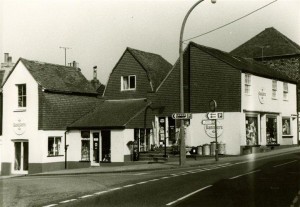
Back again to Bannisters side, next to the ironmonger is a passage which goes down brick steps to the Crown field. Next a small unattached shop selling wet fish owned by a Mr Salmon, who was an extremely jolly man who every body called George. He used to find time to visit the Rye Memorial Hospital each day and leave some fruit for the patients. Then we had Jim (Jumbo) Hollands and Son Jim, whom I went to school with. They had a grocery shop at 12 Cinque Ports Street and young Jim, who was trained as a pastry cook at Jempsons Bakery next door to the Landgate, cooked pastries and cakes to sell in the shop at a small bakehouse they rented in in the Needles. After the War young Jim Hollands started a Television Shop at No. 12 with his own son, another Jim. He would come along with a new television set and say “its time you had a new telly”. I knew him well, I was at school with him and now I have got to know his son, who is Editor of “Rye’s Own”.
From No. 12 on to the gate of the Crown field, Cinque Ports Street was a big house called Albion House, one of the two Golden Brothers lived there but traded at 109 High Street, later run by “Britcher and Rivers” a clothes shop. It is still called Britchers & Rivers but now sells retro sweets and candy. Meanwhile Albion House was taken over by Walter Stocks and altered into a large furniture shop which took up part of the Crown field. In my younger days the whole of Crown field was used entirely by “Ellis Brothers” builders.
A biggish building inside the Cinque Ports Street complex was, in my very young days, called “The Ceramic Store” but I can only really remember it being a carpenter and joiner workshop and offices of “Ellis Brothers”. There were other smaller buildings dotted about and one two storey building was close to the road and the ground floor was the paint shop for the firm. There was a homeless man suffering with religious manier and George Ellis let him live upstairs from where he could be heard preaching sermons to himself by people in the street.
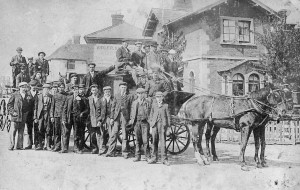
Before I leave this important section of Cinque Ports Street I must mention that what I knew as Albion House. After several changes it is a big DIY shop. There were offices in the building that stands out a bit in front of Ellis’ (auctioneer etc; Vider and Company, Holden Stutely). It was used as an Estate Agents by the Rye Auctioneers after WWII.
Now we drift towards the Railway Station, I was at school in 1925, and we were being thinking of not much more than trains that year so I gathered we had then been having trains for seventy-five years, so the railway companies had been digging in for a long time and it was a large piece of ground off Cinque Ports Street they took over (with less fuss than the supermarkets now, no doubt) So having passed along a piece of Ellis’ property we come to the gate house of the South Eastern and Chatham Railway, with its gate keeper, John Fautley and his family. Mr Fautley was officially the gate keeper who worked full time on the line. The gates to Station Approach were very heavy and swung on two big brick and stone pillars, sort of in line with the Cinque Ports Street frontages, the gates were closed every night after the last train had departed. Now we are beside the gate pillar on the market side of the station approach where the railway built “The Railway Pub” which has later been re-named the “Cinque Ports Hotel”. This was built in 1929 with a set of stables and cart shed behind and I well remember when the horses were delivering goods to shops. The shoppers made pets of them as they stopped from shop to shop, they would pat their noses and give them tit bits. They were real good pals of the public. The railway must have obtained a lot of ground in behind their Cinque Ports Street entrance.
Starting with station approach if we now turn left we come into what was, in my young days, a railway marshalling yard. When I was a boy that piece of ground was more interesting than today’s grocer stores. We were interesting in seeing the marshal with his long stick uncoupling the trucks as they were shunted into thier sidings. Trucks containing mixed loads were pushed into the Goods Shed where a platform allowed them to be unloaded by hand. Goods could be collected or delivered to the shed by the afore mentioned horse transport. Another gate took one into Ferry Road, but that is going away from Cinque Ports Street. I will be back when I deal with market frontage but right now I’m swinging back across the road to opposite Albion House.
Here was a proper mess which indicated that it was, at one time, farming land. Not only did the old barn look terribly out of place but smelt so as well. Not smells that I disliked but some people did. Wright and Pankhurst sold from it with entrance through the space in the building beside it. “Wright and Pankhurst” was an interesting Rye firm, who called themselves Jobmasters, they tried their best in those days to keep the population warm and well fed. They sold logs, coal and coke retail and people could be seen coming out with sacks of all the fire burning material and now I’m thinking about it, I can smell it too and hear the arguments between the customer and the firms man, Mr Chandler (I think) because a chestnut log or two had got in with a bag of oak – and of course chestnut was known for spitting sparks on to the sitting room carpet and burning a hole. Wright & Pankhurst were their own timber men, owning teams of shire horses and timber tugs. There were other horses working in town in my time. I remember horse taxis attending the trains “Wright and Pankhurst traded other things as well as fuel from the old barn. Seed and eating potatoes were great thing as well as seed vegetables of all sorts. After we pulled the barn down, the firm operated from the agriculture hall (now Rope Walk Mews) and around Christmas time they held “fat stock” shows in there and there was no doubt about the term “fat” but I’m going astray so back to the barn site which was being got ready for us to build on.
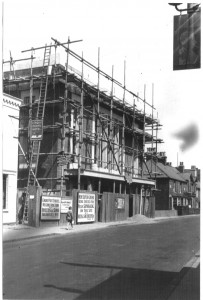
Hardly had we got started than we got the cinema contract. Economic conditions then were no better then than now and unemployment was worrying, as it is today. Our firm was lucky in that it had work, not only down the length of Cinque Ports Street but outside the town too. We knew for a long time, that a new cinema was on the cards. An older bricklayer, head of a family, kept on worrying us as to who had got the cinema contract, until we got fed up with him and told him to stop on about it, as he would have drifted on the new site. Our gamble was right and our firm had all the building workers in Rye and had quite a few in from the villages and there seemed great enthusiasm in what amounted to building a street.
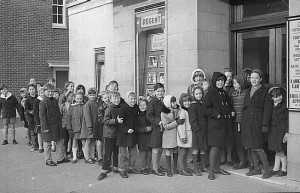
One night my mate helping me on some finishing piece on the shops suddenly realised it was gone six and he had missed his train home, another thing on the shops I will never forget was seeing a retired bricklayer watching us. I offered him my trowel and said lay one more before you pack up completely. He took it and beamed a great smile but when he tried to pick up a brick, he couldn’t and he went off crying. Wish I hadn’t done that and now I am rather old I can’t pick one up although my grip seems good.
Moving on from the new shops to the corner of Market Road, Jempson now have a restaurant in the corner shop. That building has housed many businesses in my lifetime.
Now slip across the bottom of Market Road from Jempsons Restaurant to Phillips and Stubbs – nice big new looking building where they sell houses. I said new looking, well to me it is new, I first remember that site with rather rubbishy looking small building scattered about it, mainly offices, for the Borough Surveyor Council foreman and in the space at the back, a stonemasons yard which strictly was in Market Road, although the front of the site bordered “Cinque Ports Street”.
The buildings in front were pulled down whilst I was still at school and the newest shop built over the while of the front after and a young bricklayer who had just finished his training worked on it and he was killed in WW2.
